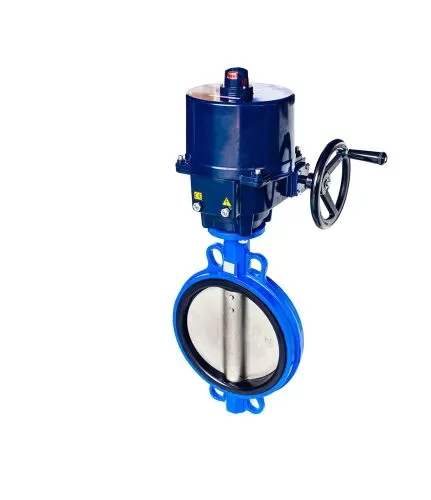Notifications

7 minutes, 49 seconds
-103 Views 0 Comments 0 Likes 0 Reviews

In today’s industrial landscape, butterfly valves play a vital role in regulating flow in pipelines across a variety of industries—from water treatment and chemical processing to power generation and HVAC systems. However, the efficiency and performance of a butterfly valve depend not only on the valve body itself but also on the actuator that operates it.
Choosing the right actuator for a butterfly control valve is critical to ensuring optimal system performance, safety, and long-term reliability. Actuators are the components responsible for moving the valve disc to open, close, or throttle flow through the pipeline. The method by which this movement is achieved varies depending on the actuator type—manual, electric, pneumatic, or hydraulic.
This comprehensive guide will walk you through the main types of butterfly valve actuators, key factors influencing actuator selection, and the ideal applications for each type. Whether you're an engineer planning a new system or a maintenance professional replacing existing equipment, this guide will help you make an informed decision.
A butterfly valve actuator serves as the driving force behind the valve’s movement. It connects to the valve’s shaft and manipulates the disc position to allow fluid to pass through, be throttled, or be completely shut off. The efficiency of this operation depends heavily on selecting the appropriate actuator type.
Actuators can be as simple as a manual hand lever or as complex as a remotely controlled, automated electric or pneumatic unit. In automated systems, actuators play a critical role by integrating with control systems to manage fluid flow without human intervention.
When selecting a butterfly valve actuator, multiple factors must be considered to match the actuator with the application’s requirements, including:
Frequency of Operation
Occasional use (e.g., maintenance or emergency shutdown) may only require manual actuators. Frequent or automated operation favors electric, pneumatic, or hydraulic actuators.
Valve Size and Torque Requirement
Larger valves require higher torque, making manual actuators impractical without gearboxes. Pneumatic or hydraulic actuators are preferred for high-torque applications due to their power-to-size ratio.
System Pressure and Media Type
Hydraulic actuators excel in high-pressure or abrasive media environments. Pneumatic actuators also perform well in medium to high-pressure systems but need clean, dry air.
Response Time
Pneumatic actuators provide rapid response, ideal for emergency shut-off and process control. Electric actuators operate slower but offer precise positioning.
Power Source Availability
Electric and pneumatic actuators depend on available power (electricity or compressed air). Manual actuators require no external power, suitable for remote locations.
Environmental Conditions
Environments with explosive gases or moisture may limit electric actuator use. Pneumatic and hydraulic actuators often better withstand harsh conditions.
Cost
Manual actuators are most cost-effective upfront, followed by electric, pneumatic, and hydraulic. Automated actuators have higher initial costs but can reduce labor and improve performance long-term.
Description:
Operated by hand via a handwheel, lever, or gearbox. Gearboxes reduce force for valves larger than 12 inches.
Key Features:
No power required
Simple installation and maintenance
Suitable for infrequent operation
Lever or gear options
Applications:
Water supply
HVAC
Agricultural irrigation
Emergency manual override
Advantages:
Low cost
Ideal for remote or isolated locations
Fail-safe by default
Disadvantages:
No automation
Requires human operation
Unsuitable for large/high-pressure valves
Description:
Motor-driven actuators powered by AC or DC current, integrated with control systems for precise flow regulation.
Key Features:
Supports automation and modulation
Torque limiters and position indicators
Remote control and diagnostics
Applications:
Water treatment
Food & beverage
Pharmaceuticals
Building management systems
Advantages:
Accurate, programmable control
Quiet operation
Suitable for continuous use
Disadvantages:
Slower response time than pneumatic
Not ideal in wet or explosive environments
Higher upfront cost
Description:
Uses compressed air to drive piston or diaphragm for valve rotation. Suitable for fast, repeatable movements.
Key Features:
Fast response
Double-acting or spring-return types
Compatible with positioners and limit switches
Lower installation cost than hydraulic
Applications:
Chemical processing
Oil & gas pipelines
Power plants
Fire protection
Advantages:
Rapid actuation
Compact and lightweight
Good for hazardous environments
Easy control system integration
Disadvantages:
Requires clean, dry air
Can be noisy
Air leaks reduce efficiency
Description:
Uses pressurized hydraulic fluid to generate torque, ideal for large or high-pressure valves.
Key Features:
High torque output
Robust and reliable under pressure
Available in linear and rotary designs
Applications:
Marine and offshore
Mining
Heavy-duty water systems
Steel and paper manufacturing
Advantages:
Handles large valves and extreme conditions
Smooth, powerful operation
Disadvantages:
Higher cost and complexity
Requires hydraulic fluid and maintenance
Potential for leaks
| Actuator Type | Power Source | Best For | Response Time | Automation | Cost | Suitability for Harsh Environments |
|---|---|---|---|---|---|---|
| Manual | None | Small, infrequently operated | Slow | No | Low | Basic use only |
| Electric | Electricity | Precise control, indoor use | Moderate | Yes | Medium | Poor in wet/explosive settings |
| Pneumatic | Compressed Air | Fast operation, automation | Fast | Yes | Medium-High | Excellent |
| Hydraulic | Hydraulic Fluid | High torque, large valves | Fast | Yes | High | Excellent |
Selecting the right actuator for a butterfly valve depends on your specific application requirements, including valve size, system pressure, operation frequency, environment, and budget. Manual actuators suit simple, rarely operated systems, while electric, pneumatic, and hydraulic actuators provide enhanced control and automation for demanding uses.
Pneumatic actuators offer a balanced choice in cost, speed, and reliability, electric actuators excel where precise control and power availability exist, and hydraulic actuators are unmatched for heavy-duty, high-torque needs.
Careful evaluation ensures optimal valve performance, safety, and longevity, enabling engineers and facility managers to optimize their fluid control systems effectively.Know more about Google SEO Directory

